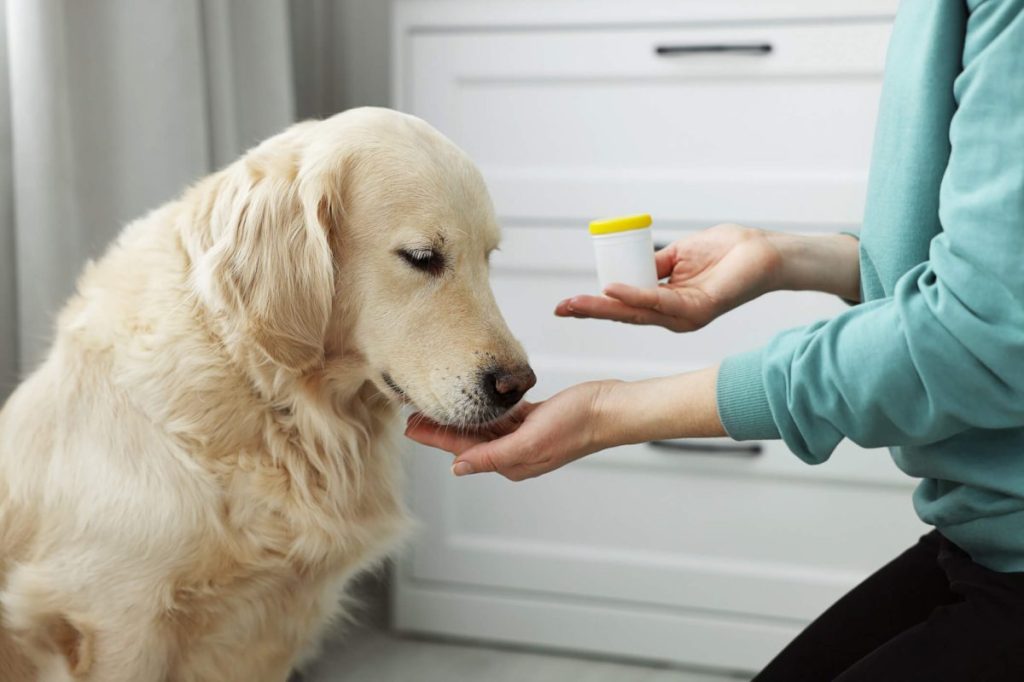Benadryl for Dogs: Dosage, Uses, & Side Effects

Benadryl — also known by its generic name diphenhydramine — is an over-the-counter antihistamine commonly used to relieve symptoms of allergies, hay fever, and the common cold in humans. It works by blocking the action of histamine, a substance in the body that causes allergic symptoms. While Benadryl is not FDA-approved for use in canines and other animals, it can still be administered to dogs under certain circumstances with proper guidance from a veterinarian.
Here’s what you should know about Benadryl’s uses, dosage, and side effects for dogs.
What is Benadryl used to treat in dogs?

Benadryl is often used to treat a variety of conditions in dogs, including:
- Allergic reactions: Dogs can suffer from allergies just like humans. Benadryl can help alleviate symptoms such as itching, swelling, and hives caused by allergic reactions to insect bites, food, or environmental factors. Sometimes, veterinarians may recommend Benadryl to prevent or mitigate mild allergic reactions that can occur after vaccinations.
- Motion sickness: Some dogs experience motion sickness during car rides. Because the active ingredient in Benadryl — diphenhydramine — is similar to the active ingredient in Dramamine — dimenhydrinate — Benadryl can be used to treat nausea and travel sickness.
- Anxiety and stress: In certain cases, Benadryl’s sedative properties can help calm dogs who are anxious or stressed, such as during fireworks, thunderstorms, or vet visits.
- Insomnia: For dogs that have trouble sleeping, Benadryl can sometimes be used to promote relaxation and induce sleep.
Dosage of Benadryl for dogs

The following is a guideline for the typical use of the drug in dogs and must not replace your vet’s advice for your individual pet.
If you’re wondering, “How much Benadryl can I give my dog?” it usually depends on several factors, such as your dog’s age, weight, and health condition. Generally, the typical dosage recommended is 1 mg of Benadryl per pound of body weight, administered every eight to 12 hours — two to three times a day. For example, a 25-pound dog would typically receive 25 mg of Benadryl, which usually equates to one tablet. However, make sure to check the dosage on the package; don’t assume that every product will be the same.
Benadryl comes in various forms, including tablets, liquid, and topical creams. Liquid Benadryl should be avoided unless specifically recommended by a vet, as it often contains alcohol which is harmful to dogs. Moreover, always use plain Benadryl and steer clear of formulations with added ingredients such as acetaminophen, pseudoephedrine, or xylitol, as they can be toxic to dogs.
For small dogs, you may consider using the children’s formula, which has less of the active ingredient of diphenhydramine and may be easier to measure out. The children’s formula of liquid Benadryl typically contains no alcohol. That said, be sure to double-check any generic formulations of the medication.
Benadryl typically begins to take effect in dogs within 30 minutes to an hour after administration. In most cases, it’s better to administer the medication before exposure to allergens. Follow your vet’s guidelines, and if they recommend a regimen, stick to it for the entire duration of their advisement, even if symptoms seem to disappear.
Side effects of Benadryl for dogs

The side effects of Benadryl in dogs are similar to the side effects humans might experience with the drug. These include:
- Drowsiness
- Dry mouth
- Urinary retention
- Rapid breathing
- Increased heart rate
- Diarrhea
- Vomiting
- Loss of appetite
If you notice any severe reactions or if your dog seems unusually lethargic or unresponsive, contact your veterinarian immediately.
It is important to note that Benadryl is the brand name and not the name of the drug that treats allergies. Diphenhydramine is the active drug in Benadryl that is safe for dogs. There are many other brands that make similar products, and there are other drugs under the Benadryl brand that you must use caution to avoid. Read the ingredients of the medication before giving it to your pet. Cetirizine may also be present, and while it may be safe, there’s no need to expose your dog to it if it isn’t necessary.
When should you avoid giving Benadryl to your dog?
Not all dogs are suitable candidates for Benadryl treatment. It should be used with caution or avoided entirely in dogs with certain medical conditions, such as:
- Glaucoma
- Severe heart disease
- High blood pressure
- Lung disease
- Enlarged prostate
- Bladder issues
Puppies may not be able to safely handle the drug. Additionally, dogs who are pregnant or nursing should never be given medication without strict veterinary supervision.
Certain drugs — including CNS depressant agents, anticholinergic drugs, and tricyclic antidepressants — can cause a dangerous reaction when combined with Benadryl. So, inform your vet about any other medications your dog is taking.
If you realize you’ve missed giving a dose of Benadryl to your dog, consult your vet for advice. They might ask you how much time has passed since the missed dose. If it’s only been a short period, such as an hour or two, you can administer the missed dose of diphenhydramine immediately. However, if it is close to the time for the next scheduled dose, it’s generally recommended to skip the missed dose entirely and continue with the regular dosing schedule. Do not double up on doses to make up for the missed one, as this could lead to an overdose.
An overdose can be fatal. If your dog takes too much diphenhydramine, call the emergency vet or ASPCA Animal Poison Control Center (APCC) at (888) 426-4435 right away. Symptoms of overdose include dilated pupils, constipation, rapid heartbeat, behavioral changes, and seizures.
What are some alternatives to Benadryl for dogs?

If your dog cannot take Benadryl or you wish to avoid certain side effects, you may consult your vet about alternative medications. Depending on what your dog is allergic to, there may be various treatment options available.
The first step is to limit exposure to allergens. If your pet suffers from allergies to dust, pollen, or other things that they might track in from outside the home, make sure you’re washing their bedding regularly and keeping your home clean. Occasional bathing as recommended by your vet and frequent brushing can also go a long way in keeping allergens out of your dog’s coat. An oatmeal bath may help soothe itches and remove allergens. Moreover, be sure to wash or clean their paws everytime they come inside after a walk.
Some dogs suffer from food allergies. These can be difficult to spot, but if you suspect a food allergy, talk to your vet. They can make some recommendations for dietary changes that might alleviate some of your dog’s symptoms.
If your dog has seasonal allergies, several natural remedies might be effective. Apple cider vinegar, coconut oil, aloe vera, and some supplements can help reduce itching. That said, always consult your veterinarian before starting any new supplements or natural remedies for your pet.







